KPackageKit
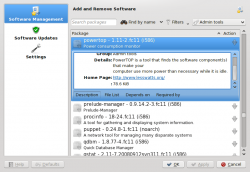 |
Et grafisk værktøj til at håndtere dine pakker |
Hovedtræk
- Manages installation and un-installation of packages
- Manages package updates
- Can be searched by package-name, description, or included file name
- Supports filtering on
- Installed or available
- Free or non-free
- End-user or development
- Graphical or text-only
- Can be viewed in package groups
Installing packages
Hvis du kender pakkens navn så skal du blot skrive dette i søgelinjen - som standard søges der efter navn.
Antag nu, at du har brug for foreslag til passende pakker. I så fald vælger du . Skriver du eksempel "flaac" i søgelinjen og vælger , så bliver du præsenteret for alle de pakker, som har at gøre med brugen af flaac-filer. Installerede pakker viser et gråt X (som bliver brugt, hvis du vil fjerne noget) og tilgængelige pakker har en grå nedadpegende pil.
Således ser du en liste af relevante filer. Klikker du på en af dem, så åbnes et panel med en beskrivelse af filen (Forstør billedet ovenfor for at se dette og brug så din browsers -knap for at komme hertil igen). Der er tre andre valgmuligheder for visning - en liste af filer inkluderet i pakken, en liste af afhængigheder (som vil blive håndteret automatisk, hvis du vælger at installere pakken)
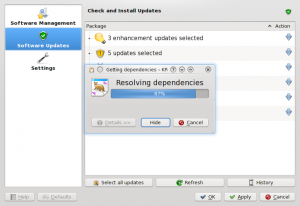
and a list of applications that depend upon the package you choose.
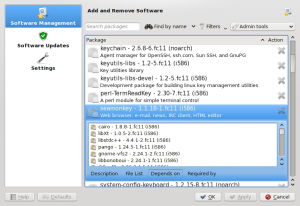
Having found the application that is best for you, click on the down-arrow and you will see both the package icon and the action icon become active. Click OK, and your package will be installed.
Updating your packages
The second section lists any packages for which updates are available. As before, the repos and your installation are queried, so there is a delay. When the list is created, it is presented in groups.
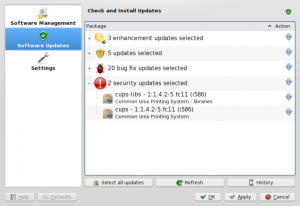
Again, dependencies are resolved when you agree to the download.
Configuration Options
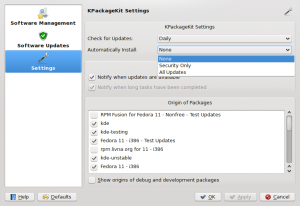
The third and final section of KPackageKit is the page. Here you can set the frequency of checking for updates, according to your need. The default is , but for an ultra-secure site you could choose Hourly, and for a lightly used one you can have or frequency.
Next is whether you want updates to be installed automatically. A nice touch is to be able to say that security updates should be automatically installed, but no other packages.
The next choice is whether you want the tray icon to notify you of available updates, and whether it should tell you when large jobs are finished.
The final section lists all the repos you have set up. Here you can enable or disable individual repos.
The Tray Icon
Finally, the tray icon can give you some information while your install or upgrade is progressing.

Here you can see the progress of your batch of updates or installs. A simple hover over the icon gives you a percentage reading of the job.

